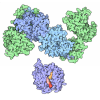[English] 日本語
 Yorodumi
Yorodumi- PDB-6mid: Cryo-EM structure of the ZIKV virion in complex with Fab fragment... -
+ Open data
Open data
- Basic information
Basic information
| Entry | Database: PDB / ID: 6mid | |||||||||
|---|---|---|---|---|---|---|---|---|---|---|
| Title | Cryo-EM structure of the ZIKV virion in complex with Fab fragments of the potently neutralizing human monoclonal antibody ZIKV-195 | |||||||||
 Components Components |
| |||||||||
 Keywords Keywords | VIRUS/IMMUNE SYSTEM / virus / monoclonal antibody / complex / VIRUS-IMMUNE SYSTEM complex | |||||||||
| Function / homology |  Function and homology information Function and homology informationflavivirin / symbiont-mediated suppression of host JAK-STAT cascade via inhibition of host TYK2 activity / immunoglobulin complex / symbiont-mediated suppression of host JAK-STAT cascade via inhibition of STAT2 activity / symbiont-mediated suppression of host JAK-STAT cascade via inhibition of STAT1 activity / negative regulation of innate immune response / viral capsid / double-stranded RNA binding / nucleoside-triphosphate phosphatase / 4 iron, 4 sulfur cluster binding ...flavivirin / symbiont-mediated suppression of host JAK-STAT cascade via inhibition of host TYK2 activity / immunoglobulin complex / symbiont-mediated suppression of host JAK-STAT cascade via inhibition of STAT2 activity / symbiont-mediated suppression of host JAK-STAT cascade via inhibition of STAT1 activity / negative regulation of innate immune response / viral capsid / double-stranded RNA binding / nucleoside-triphosphate phosphatase / 4 iron, 4 sulfur cluster binding / clathrin-dependent endocytosis of virus by host cell / mRNA (guanine-N7)-methyltransferase / methyltransferase cap1 / molecular adaptor activity / adaptive immune response / methyltransferase cap1 activity / mRNA 5'-cap (guanine-N7-)-methyltransferase activity / RNA helicase activity / protein dimerization activity / immune response / host cell perinuclear region of cytoplasm / host cell endoplasmic reticulum membrane / RNA helicase / symbiont-mediated suppression of host type I interferon-mediated signaling pathway / symbiont-mediated activation of host autophagy / serine-type endopeptidase activity / RNA-directed RNA polymerase / viral RNA genome replication / RNA-directed RNA polymerase activity / fusion of virus membrane with host endosome membrane / viral envelope / centrosome / lipid binding / GTP binding / virion attachment to host cell / host cell nucleus / virion membrane / structural molecule activity / ATP hydrolysis activity / proteolysis / extracellular region / ATP binding / metal ion binding / membrane / plasma membrane Similarity search - Function | |||||||||
| Biological species |   Zika virus Zika virus Homo sapiens (human) Homo sapiens (human) | |||||||||
| Method | ELECTRON MICROSCOPY / single particle reconstruction / cryo EM / Resolution: 4 Å | |||||||||
 Authors Authors | Long, F. / Rossmann, M.G. | |||||||||
| Funding support |  United States, 1items United States, 1items
| |||||||||
 Citation Citation |  Journal: Proc Natl Acad Sci U S A / Year: 2019 Journal: Proc Natl Acad Sci U S A / Year: 2019Title: Structural basis of a potent human monoclonal antibody against Zika virus targeting a quaternary epitope. Authors: Feng Long / Michael Doyle / Estefania Fernandez / Andrew S Miller / Thomas Klose / Madhumati Sevvana / Aubrey Bryan / Edgar Davidson / Benjamin J Doranz / Richard J Kuhn / Michael S Diamond ...Authors: Feng Long / Michael Doyle / Estefania Fernandez / Andrew S Miller / Thomas Klose / Madhumati Sevvana / Aubrey Bryan / Edgar Davidson / Benjamin J Doranz / Richard J Kuhn / Michael S Diamond / James E Crowe / Michael G Rossmann /  Abstract: Zika virus (ZIKV) is a major human pathogen and member of the genus in the Flaviviridae family. In contrast to most other insect-transmitted flaviviruses, ZIKV also can be transmitted sexually and ...Zika virus (ZIKV) is a major human pathogen and member of the genus in the Flaviviridae family. In contrast to most other insect-transmitted flaviviruses, ZIKV also can be transmitted sexually and from mother to fetus in humans. During recent outbreaks, ZIKV infections have been linked to microcephaly, congenital disease, and Guillain-Barré syndrome. Neutralizing antibodies have potential as therapeutic agents. We report here a 4-Å-resolution cryo-electron microscopy structure of the ZIKV virion in complex with Fab fragments of the potently neutralizing human monoclonal antibody ZIKV-195. The footprint of the ZIKV-195 Fab fragment expands across two adjacent envelope (E) protein protomers. ZIKV neutralization by this antibody is presumably accomplished by cross-linking the E proteins, which likely prevents formation of E protein trimers required for fusion of the viral and cellular membranes. A single dose of ZIKV-195 administered 5 days after virus inoculation showed marked protection against lethality in a stringent mouse model of infection. | |||||||||
| History |
|
- Structure visualization
Structure visualization
| Movie |
 Movie viewer Movie viewer |
|---|---|
| Structure viewer | Molecule:  Molmil Molmil Jmol/JSmol Jmol/JSmol |
- Downloads & links
Downloads & links
- Download
Download
| PDBx/mmCIF format |  6mid.cif.gz 6mid.cif.gz | 337.5 KB | Display |  PDBx/mmCIF format PDBx/mmCIF format |
|---|---|---|---|---|
| PDB format |  pdb6mid.ent.gz pdb6mid.ent.gz | 276.4 KB | Display |  PDB format PDB format |
| PDBx/mmJSON format |  6mid.json.gz 6mid.json.gz | Tree view |  PDBx/mmJSON format PDBx/mmJSON format | |
| Others |  Other downloads Other downloads |
-Validation report
| Summary document |  6mid_validation.pdf.gz 6mid_validation.pdf.gz | 1.6 MB | Display |  wwPDB validaton report wwPDB validaton report |
|---|---|---|---|---|
| Full document |  6mid_full_validation.pdf.gz 6mid_full_validation.pdf.gz | 1.6 MB | Display | |
| Data in XML |  6mid_validation.xml.gz 6mid_validation.xml.gz | 76 KB | Display | |
| Data in CIF |  6mid_validation.cif.gz 6mid_validation.cif.gz | 109.8 KB | Display | |
| Arichive directory |  https://data.pdbj.org/pub/pdb/validation_reports/mi/6mid https://data.pdbj.org/pub/pdb/validation_reports/mi/6mid ftp://data.pdbj.org/pub/pdb/validation_reports/mi/6mid ftp://data.pdbj.org/pub/pdb/validation_reports/mi/6mid | HTTPS FTP |
-Related structure data
| Related structure data |  9131MC M: map data used to model this data C: citing same article ( |
|---|---|
| Similar structure data |
- Links
Links
- Assembly
Assembly
| Deposited unit | 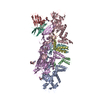
|
|---|---|
| 1 | x 60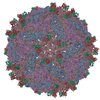
|
| 2 |
|
| 3 | x 5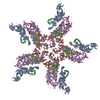
|
| 4 | x 6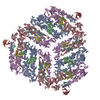
|
| 5 | 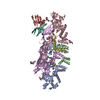
|
| Symmetry | Point symmetry: (Schoenflies symbol: I (icosahedral)) |
- Components
Components
| #1: Protein | Mass: 54444.051 Da / Num. of mol.: 3 / Fragment: UNP residues 291-794 / Source method: isolated from a natural source Source: (natural)  Zika virus (isolate ZIKV/Human/French Polynesia/10087PF/2013) Zika virus (isolate ZIKV/Human/French Polynesia/10087PF/2013)Strain: isolate ZIKV/Human/French Polynesia/10087PF/2013 / References: UniProt: A0A024B7W1 #2: Protein | Mass: 8496.883 Da / Num. of mol.: 3 / Fragment: UNP residues 216-290 / Source method: isolated from a natural source Source: (natural)  Zika virus (isolate ZIKV/Human/French Polynesia/10087PF/2013) Zika virus (isolate ZIKV/Human/French Polynesia/10087PF/2013)Strain: isolate ZIKV/Human/French Polynesia/10087PF/2013 / References: UniProt: A0A024B7W1 #3: Antibody | | Mass: 14148.739 Da / Num. of mol.: 1 / Fragment: Fab variable domain / Source method: isolated from a natural source / Source: (natural)  Homo sapiens (human) Homo sapiens (human)#4: Antibody | | Mass: 11750.902 Da / Num. of mol.: 1 / Fragment: Fab variable domain / Source method: isolated from a natural source / Source: (natural)  Homo sapiens (human) / References: UniProt: A0A0B4J1U3 Homo sapiens (human) / References: UniProt: A0A0B4J1U3#5: Polysaccharide | Source method: isolated from a genetically manipulated source Has protein modification | Y | |
|---|
-Experimental details
-Experiment
| Experiment | Method: ELECTRON MICROSCOPY |
|---|---|
| EM experiment | Aggregation state: PARTICLE / 3D reconstruction method: single particle reconstruction |
- Sample preparation
Sample preparation
| Component |
| ||||||||||||||||||||||||||||
|---|---|---|---|---|---|---|---|---|---|---|---|---|---|---|---|---|---|---|---|---|---|---|---|---|---|---|---|---|---|
| Molecular weight | Units: MEGADALTONS / Experimental value: NO | ||||||||||||||||||||||||||||
| Source (natural) |
| ||||||||||||||||||||||||||||
| Details of virus | Empty: NO / Enveloped: YES / Isolate: STRAIN / Type: VIRION | ||||||||||||||||||||||||||||
| Buffer solution | pH: 8 / Details: NTE buffer at pH 8.0 | ||||||||||||||||||||||||||||
| Buffer component |
| ||||||||||||||||||||||||||||
| Specimen | Conc.: 1 mg/ml / Embedding applied: NO / Shadowing applied: NO / Staining applied: NO / Vitrification applied: YES Details: Fab fragments were mixed with purified mature virus particles to make complexes. | ||||||||||||||||||||||||||||
| Specimen support | Details: unspecified | ||||||||||||||||||||||||||||
| Vitrification | Instrument: GATAN CRYOPLUNGE 3 / Cryogen name: ETHANE / Humidity: 90 % / Chamber temperature: 298 K |
- Electron microscopy imaging
Electron microscopy imaging
| Experimental equipment |  Model: Titan Krios / Image courtesy: FEI Company |
|---|---|
| Microscopy | Model: FEI TITAN KRIOS |
| Electron gun | Electron source:  FIELD EMISSION GUN / Accelerating voltage: 300 kV / Illumination mode: FLOOD BEAM FIELD EMISSION GUN / Accelerating voltage: 300 kV / Illumination mode: FLOOD BEAM |
| Electron lens | Mode: BRIGHT FIELD |
| Image recording | Electron dose: 30 e/Å2 / Detector mode: COUNTING / Film or detector model: GATAN K2 SUMMIT (4k x 4k) / Num. of real images: 1691 |
- Processing
Processing
| EM software |
| ||||||||||||||||||||||||||||||||||||||||||||||||||
|---|---|---|---|---|---|---|---|---|---|---|---|---|---|---|---|---|---|---|---|---|---|---|---|---|---|---|---|---|---|---|---|---|---|---|---|---|---|---|---|---|---|---|---|---|---|---|---|---|---|---|---|
| CTF correction | Type: NONE | ||||||||||||||||||||||||||||||||||||||||||||||||||
| Symmetry | Point symmetry: I (icosahedral) | ||||||||||||||||||||||||||||||||||||||||||||||||||
| 3D reconstruction | Resolution: 4 Å / Resolution method: FSC 0.143 CUT-OFF / Num. of particles: 10687 Details: The map was masked by removing the internal nucleic acid region and the external background region. Symmetry type: POINT | ||||||||||||||||||||||||||||||||||||||||||||||||||
| Atomic model building | Protocol: FLEXIBLE FIT / Space: REAL Details: The occupancy of bound Fabs was low. Due to poor density, only the variable domain of Fab molecule was modeled and fit into one of the three Fab binding sites on each icosahedral asymmetric unit. | ||||||||||||||||||||||||||||||||||||||||||||||||||
| Atomic model building | PDB-ID: 6CO8 Accession code: 6CO8 / Source name: PDB / Type: experimental model |
 Movie
Movie Controller
Controller


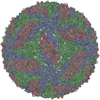
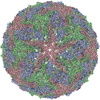
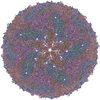
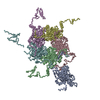
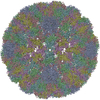
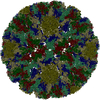

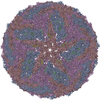
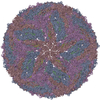
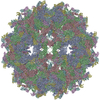
 PDBj
PDBj



